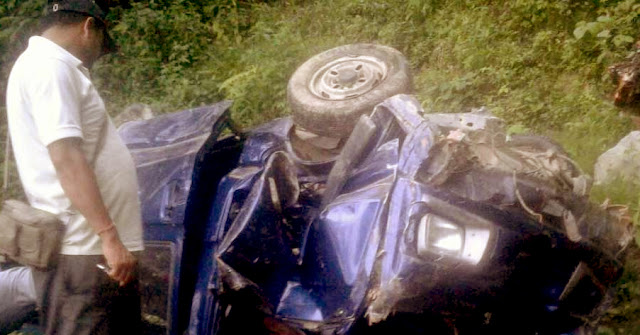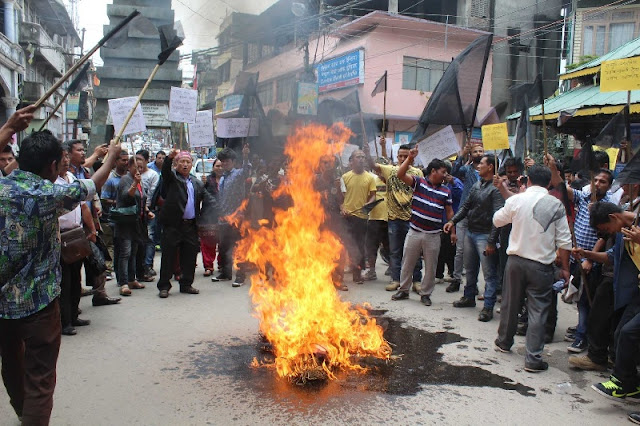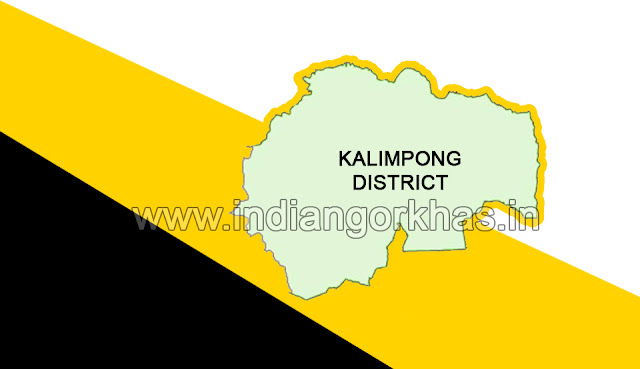West Bengal Chief Minister Mamata Banerjee on Thursday declared Kalimpong in the Darjeeling hills as the 21st district of the state. So far, Kalimpong used to be a sub-division under the Darjeeling district. Mamata, who is on a three day tour to north Bengal made the announcement while addressing the locals at the Lepcha Board Foundation Day Programme in Kalimpong.
Mamata also promised the allotment of six core rupees for the construction of proper infrastructure of the newly declared district. "Kalimpong will become a new district. We have allotted Rs 6 crore for building infrastructure here," she said on Thursday adding that tourism must flourish in the hills.
Addressing the people of the hills, Mamata said, "I want to work for the development of Darjeeling Hills. I am proud of the young generation here. If the hills do not progress, Bengal cannot progress."
In December last year Banerjee had announced that Kalimpong will be turned into a new district for ease of administration. However, many see it as a way to snub the Gorkha Janmukti Morcha (GJM) which has been leading a campaign demanding separate Gorkhaland state.
Mamata's announcement comes as a victory for the newly formed Jan Andolan Party (JAP) whose leader Harka Bahadur Chhetri have been lobbying hard to make Kalimpong a separate district after quitting the Gorkha Janmukti Morcha in September.
Mamata Banerjee showers sops on Kalimpong, Bimal Gurung says it’s ‘land of Gorkhaland lovers’
With Chief Minister Mamata Banerjee on Thursday announcing a slew of development measures in Kalimpong — which will soon be carved into a separate district — her one-time political ally Bimal Gurung of the Gorkha Janmukti Morcha (GJM) claimed that the hill town was the “land of Gorkhaland lovers”.
Speaking at the foundation day programme of the Lepcha Board, Mamata said: “The Lepcha Board has already built three thousands of homes for the poor. The various development boards must promote cultural activities and make Darjeeling clean and green. We want Darjeeling to prosper and become the best. Kalimpong will become a new district. We have allotted Rs 6 crore for building infrastructure.” Mamata is currently on a three-day trip to the hills concluding on Friday.
Ahead of addressing a rally in Kalimpong, Mamata met several local leaders, including those from the Lepcha, Tamang, Newa, Bhujal, Khas, Kami, Damai, Saki, Vishwakarma and Gurung communities. She was also accorded the status of ‘Kingchuk Dermit’ — the highest award of the Lepcha community, said Trinamool leaders.
Gurung calls meet to counter Mamata - Morcha seeks to score over Trinamul chief in Kalimpong
Bimal Gurung has decided to hold a public meeting of the Gorkha Janmukti Morcha's women wing in Kalimpong on Sunday, a day after Mamata Banerjee leaves the hill town, purportedly to show that Kalimpong is "a land of Gorkhaland lovers".
The chief minister reached Kalimpong today and will attend a programme of the Lepcha development board tomorrow, followed by another one of the Tamang development board the day after. She is scheduled to leave Kalimpong on Saturday.
In a written statement today, the Morcha president said Mamata was frequenting the hills, particularly Kalimpong, to "suppress the Gorkhaland voice" with the help of "some vested people who are trying to divide the Gorkha community into pieces" by forming development boards.
Gurung went on to say: "In reality, Kalimpong is a land of Gorkhaland lovers. However, some people with vested interests are belittling Kalimpong. The person who is dividing the Gorkha community is being felicitated as the chief minister who wants good of the Gorkhas."
He called on "Gorkhaland lovers" to look into the issue with all seriousness and asked them to give a befitting reply. "The issue of Gorkhaland cannot be suppressed by temporary benefits. To spread this message to Gorkhas across India, the Gorkha Janmukti Nari Morcha has decided to organise a meeting at Delo on September 25," Gurung said.
"The Nari Morcha members from Kalimpong should attend the meeting to demonstrate to chief minister Mamata Banerjee and anti-Gorkhaland forces the support for Gorkhaland," he added.
Delo is 5km from Kalimpong.
Even though Gurung had yesterday said the Morcha would win any election even if it was held now, his statement today, according to observers, suggests that he feels that the impact of Mamata's three-day visit has to be countered immediately.
Many hope Mamata will make some announcements with regard to the creation of Kalimpong district during her stay there. However, a senior Nabanna official said: "Creation of a new district involves a lot of paper work. But no file regarding creation of Kalimpong has moved yet."
According to sources, the personnel and administrative reforms department would first prepare the proposal and send it to the finance department before seeking clearance from the cabinet. "But nothing of that sort has happened," said a source.
Various web sources
Mamata also promised the allotment of six core rupees for the construction of proper infrastructure of the newly declared district. "Kalimpong will become a new district. We have allotted Rs 6 crore for building infrastructure here," she said on Thursday adding that tourism must flourish in the hills.
 |
| West Bengal Chief Minister Mamata Banejee wears a traditional headgear at the 5th founation day function of Lepcha Development and Cultural Board at Kalimpoog in Darjeeling |
In December last year Banerjee had announced that Kalimpong will be turned into a new district for ease of administration. However, many see it as a way to snub the Gorkha Janmukti Morcha (GJM) which has been leading a campaign demanding separate Gorkhaland state.
Mamata's announcement comes as a victory for the newly formed Jan Andolan Party (JAP) whose leader Harka Bahadur Chhetri have been lobbying hard to make Kalimpong a separate district after quitting the Gorkha Janmukti Morcha in September.
Mamata Banerjee showers sops on Kalimpong, Bimal Gurung says it’s ‘land of Gorkhaland lovers’
With Chief Minister Mamata Banerjee on Thursday announcing a slew of development measures in Kalimpong — which will soon be carved into a separate district — her one-time political ally Bimal Gurung of the Gorkha Janmukti Morcha (GJM) claimed that the hill town was the “land of Gorkhaland lovers”.
Speaking at the foundation day programme of the Lepcha Board, Mamata said: “The Lepcha Board has already built three thousands of homes for the poor. The various development boards must promote cultural activities and make Darjeeling clean and green. We want Darjeeling to prosper and become the best. Kalimpong will become a new district. We have allotted Rs 6 crore for building infrastructure.” Mamata is currently on a three-day trip to the hills concluding on Friday.
Ahead of addressing a rally in Kalimpong, Mamata met several local leaders, including those from the Lepcha, Tamang, Newa, Bhujal, Khas, Kami, Damai, Saki, Vishwakarma and Gurung communities. She was also accorded the status of ‘Kingchuk Dermit’ — the highest award of the Lepcha community, said Trinamool leaders.
Gurung calls meet to counter Mamata - Morcha seeks to score over Trinamul chief in Kalimpong
Bimal Gurung has decided to hold a public meeting of the Gorkha Janmukti Morcha's women wing in Kalimpong on Sunday, a day after Mamata Banerjee leaves the hill town, purportedly to show that Kalimpong is "a land of Gorkhaland lovers".
The chief minister reached Kalimpong today and will attend a programme of the Lepcha development board tomorrow, followed by another one of the Tamang development board the day after. She is scheduled to leave Kalimpong on Saturday.
In a written statement today, the Morcha president said Mamata was frequenting the hills, particularly Kalimpong, to "suppress the Gorkhaland voice" with the help of "some vested people who are trying to divide the Gorkha community into pieces" by forming development boards.
Gurung went on to say: "In reality, Kalimpong is a land of Gorkhaland lovers. However, some people with vested interests are belittling Kalimpong. The person who is dividing the Gorkha community is being felicitated as the chief minister who wants good of the Gorkhas."
He called on "Gorkhaland lovers" to look into the issue with all seriousness and asked them to give a befitting reply. "The issue of Gorkhaland cannot be suppressed by temporary benefits. To spread this message to Gorkhas across India, the Gorkha Janmukti Nari Morcha has decided to organise a meeting at Delo on September 25," Gurung said.
"The Nari Morcha members from Kalimpong should attend the meeting to demonstrate to chief minister Mamata Banerjee and anti-Gorkhaland forces the support for Gorkhaland," he added.
Delo is 5km from Kalimpong.
Even though Gurung had yesterday said the Morcha would win any election even if it was held now, his statement today, according to observers, suggests that he feels that the impact of Mamata's three-day visit has to be countered immediately.
Many hope Mamata will make some announcements with regard to the creation of Kalimpong district during her stay there. However, a senior Nabanna official said: "Creation of a new district involves a lot of paper work. But no file regarding creation of Kalimpong has moved yet."
According to sources, the personnel and administrative reforms department would first prepare the proposal and send it to the finance department before seeking clearance from the cabinet. "But nothing of that sort has happened," said a source.
Various web sources





















+Avinash+Gurung+at+the+Gorkha+Rangamanch+Bhavan+in+Darjeeling+on+Saturday;+Bimal+and+Asha+Gurung+in+the+audience.+Pictures+by+Suman+Tamang.jpg)


